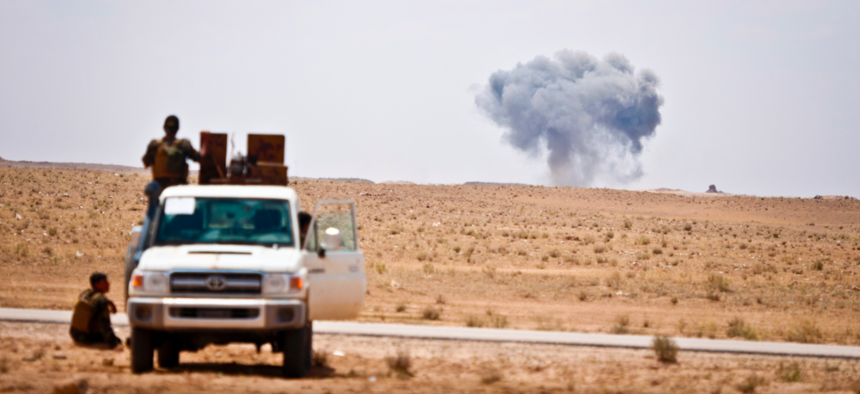
Syrian Democratic Forces watch as a Coalition airstrike hits its target on a known ISIS location near the Iraqi-Syrian border, May 13, 2018. U.S. Army photo by Staff Sgt. Timothy R. Koster
The conventional wisdom is that – with ISIS near defeat and a new commitment to at least a rump U.S. presence to keep them down – U.S.-Syria policy is finally on track. Having analyzed Syria since 2012, I’m not so sure.
First, any pronouncement of ISIS’s defeat should include the caveat “on the Coalition side of a U.S.-Russian deconfliction line.” The U.S. and Russian militaries agreed in mid-2017 to divide the ISIS fight into spheres of influence, with U.S.-backed Syrian Democratic Forces restricted to areas east of the Euphrates River. West of the river, the ISIS fight has been entrusted to Iran, Russia, and the Assad regime. Unsurprisingly, ISIS still holds territory there.
Second, ISIS sleeper cells remain potent. The January bombing that killed four U.S. service members in Manbij was just the tip of the iceberg. Since then, ISIS sleeper cells have bombed multiple SDF posts and assassinated numerous SDF officials. Moreover, elite ISIS fighters vanished into the desert after the coalition took their capital of Raqqah. Last month, the SDF also revealed that ISIS “caliph” Abu Bakr al-Baghdadi has left the country and is at large.
Related: ISIS Might Come Back. That’s Just One More Reason to Get Out of Syria
Related: Trump: US Will Be Working with Mideast Partners ‘For Many Years to Come’
Related: Army Chief Confirms US Will Hand off ISIS Fight in Syria
The current situation in Syria resembles Iraq in 2012: simmering sectarian grievances, widespread abuses by security forces, and persistent terrorist sleeper cells. These were the conditions in which Al-Qaeda in Iraq was reborn as ISIS, and these are conditions in which ISIS could be born anew. East of the Euphrates, U.S. troops might ensure a better outcome; that’s 20 percent of the country. What about the other 80 percent of Syrian territory that’s been left to the mercies of Assad?
Last July, members of the Druze religious minority in southwest Syria experienced the year’s worst ISIS massacre: nearly 250 civilians killed in Sweida. Though the attack was by ISIS, locals soon turned on the regime. Victims’ families expelled government officials from funerals. The top Druze militia held the regime responsible. Protesters called for international intervention.
Why? Because only weeks before, the regime had bused the attacking ISIS fighters to the area. Furthermore, Assad’s ally Russia was heavily pressing relatively autonomous Druze militias to integrate with regime forces. The Sweida residents concluded that that Assad had used ISIS against them. If they don’t trust him to fight ISIS, why should we?
To finish off ISIS, the United States needs a policy that fully accounts for Assad’s role in supporting the terror group. This brings us to the northwest of Syria, where 3 million civilians are crammed into the opposition stronghold of Idlib province. Russia and Turkey agreed to a ceasefire in Idlib last September, but the regime shrugged it off in mid-February. The resumption of large-scale shelling has killed more than 60 civilians in just a few weeks.
As he did in Sweida, Assad bused hundreds of ISIS fighters to Idlib last year, helping them to set up a network of sleeper cells. These fighters are reviled across the spectrum – even extremist group Hayat Tahrir al-Sham frequently conducts anti-ISIS security sweeps. But if Assad and Russia lay waste to Idlib while the world looks on, these ISIS cells could find a new foothold.
Already, groups with international terror ties are trying to recruit in Idlib, comparing the ill-enforced ceasefire to the 1992 Srebrenica “safe area” that led to the systematic slaughter of Bosnian Muslims. Should the regime choose to launch a full-out assault on this pocket of resistance, the resulting death and destruction would give these arguments dangerous weight. In a province where unemployment is a whopping 67 percent, the suffering and chaos of such an assault would also give extremists an economic opening to recruit from a huge population pool.
Conveniently for Assad, a stronger ISIS presence in Idlib would then provide a pretext for an even wider assault on the population, thereby repeating the cycle. His forces would likely succeed in asserting control over the province – but ISIS-style groups would gain a new popular, if not territorial, base for international terrorism. Assad would probably play along, just as he helped al Qaeda fighters kill U.S. troops in Iraq in the mid-2000s and released global terror masterminds from Syrian jails in 2011. The United States, therefore, has a national security interest in defending Idlib.
The last time Assad and Russia geared up to attack Idlib, President Trump warned that such an attack would be a “grave humanitarian mistake.” This diplomatic pressure helped stave off an attack and led to the current Idlib ceasefire. Trump’s statements were effective because the United States had recently struck Assad’s chemical sites and had troops in Syria, giving America “skin in the game” even in areas where troops were not physically located.
As Assad tries to weasel out of yet another ceasefire, the Trump administration should use the remaining U.S. troops to dissuade the Syrian leader from an Idlib assault. Air strikes remain an option even as the number of American ground troops dwindles. Such strikes in retaliation for attacks on civilians would give the regime, already reeling from an internal economic crisis, serious pause about continuing the slaughter.
America’s Syria policy can’t just be about defeating ISIS in a given plot of land. It must also account for the ways that Assad’s backing might keep the group alive — and might sow the seeds for even worse.



